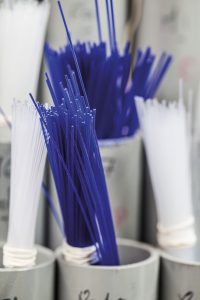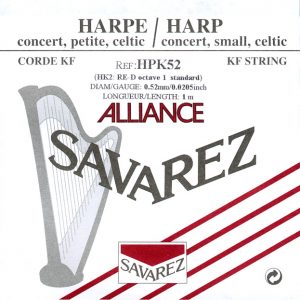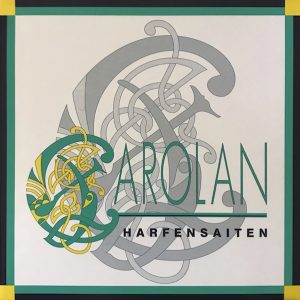Camac Blog
Fabulous Fluorocarbon
Latest
October 14, 2019
Harpists are often curious about our “carbon strings”. These strings are actually made of fluorocarbon, but they’re commonly called “carbon” for short. Whatever their name, composite strings are a relative newcomer, in comparison to gut and nylon. We have had such good experiences with this material, that we have optimised the construction of many of our lever harps to work perfectly with them. This includes top-of-the-range instruments, in response to requests from professionals.
Fluorocarbon is much sought-after for its resistance capabilities. It stretches much less than nylon, which means it breaks less often and holds its tuning better. Its density is very close to gut, giving a similarly rich timbre. It therefore emerged as a gut substitute, particularly taken up by period instruments at the beginning.
Our own journey with fluorocarbon strings began when Savarez informed us they were making them. Savarez is a famous, long-established French string maker – they made strings for Erard, so their savoir-faire goes back a long way. The fluorocarbon strings we first discovered were Savarez’s KF, for pedal harps. Their gauges were the same as gut strings, but we found that the tension was a little heavier, probably because the density of fluorocarbon is slightly higher than gut.
“I was not convinced by this for the pedal harp”, Jakez François remembers. “You have to take into account that the tension on pedal harps is highly standardised; harpists do not expect much variation. I didn’t think this was an ideal field to change. The lever harp, on the other hand, doesn’t have a formalized tension concept, and I immediately saw huge potential for fluorocarbon on these instruments.
Fluorocarbon sounds rich like gut, but it lasts much longer, holds its tuning well, and it is cheaper. This made it an ideal choice for student instruments, and we conceived the Hermine – one of our entry-level bestsellers – for these strings.
As time went on, fluorocarbon proved its worth over and over again. Professional lever harpists asked us if we could not also use it at the top of our range. They particularly envied the fact that fluorocarbon holds its tuning better than any other material. It was in response to these requests from artists that the Aziliz was born. We also extended fluorocarbon to our 38-string harps, with the creation of the Isolde.
Today, our two best-selling lever concert harps are also strung with fluorocarbon. The Ulysse uses the same gauge as the Aziliz, Isolde, Hermine, and also an electric harp, our DHC 32. As for the Excalibur: we designed this harp together with François Pernel, and he wanted a particularly strong and powerful sound for the instrument. For this, I decided to use fluorocarbon strings by Kürschner instead of by Savarez. The fluorocarbon material is the same, but Kürschner’s lower register strings are monofilament, whereas Savarez is plaited multifilament. Monofilament strings have more projection. If you’re wondering why we don’t then use them everywhere – they also stretch more. Also, the world is big enough for more than one sound concept, particularly in the incredibly diverse lever harp world. We try to offer a big range of stringing and tensions, to serve this musical variety.”
If you’re ever unsure exactly which strings to order for your harp, don’t forget that each harp page on camac-harps.com has handy links, transporting you straight to your strings on our online store! You can also consult our string charts on our service page.





I was wondering if I could use the carbon strings on my Lyon & Healy Shamrock 34 string lever harp for the 3rd and 4th octave?
Hello Murray, thank you for your interest. The best thing to do is to seek advice from Lyon and Healy. If they say it’s fine, it will surely be no problem. Best regards, Camac Harps
Isn’t there a way to check out Camac Harps that show prices/ ? I can’t even consider what I want to purchase without a realistic price look?
Dear Halana Marie, the reason we don’t publish prices online at manufacturer source is because you may prefer a price in your currency and including any necessary import taxes etc. If you let us know where you are based (either here or by emailing [email protected]), we will send you a price list. Alternatively you can find your nearest Camac distributor here: https://www.camac-harps.com/en/general-distribution/
and contact them directly.
Best regards,
Camac Harps
Can I use the carbon strings on my Camac Talinn? Which brand would you suggest?
Hi, have an old Rydecki 36 lever harp, in beautiful shape and I just put new nylon strings on it, but I am not totally happy with the sound. I would like to try fluorocarbon on the middle two octaves. I have a string chart, is this something I could order from you? I am especially interested in the Kitchener monofilament strings for the octave above the would metal strings as that octave seems to be the most troublesome on many lever harps. The would nylon strings are so big and clunky and never hold tune as well as the rest of the strings. I am I. The US. Thanks for your help!
I’m wondering what happens to Fluorocarbon strings with the potential upcoming PFAS ban in Europe?
I guess, if this ban is going to happen, it will be very difficult to get any Fluorocarbon strings in the future.
All industries which are dependent on PFAS already looking for replacement. Is Camac doing the same?
What happens to Camac harps with those strings, if they are not available anymore?